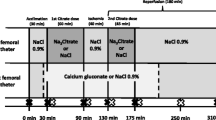Abstract
We investigated the cytoprotective effects of verapamil, a Ca channel blocker, and of iloprost (ZK 36374), a stable prostacyclin analogue, on ischemia/reperfusion (I/R) injury in Wistar albino rat kidneys that were subjected to 60 min of warm ischemia and reperfusion. The groups included sham, ischemia-untreated (ISCH), verapamil-treated (VER), iloprost-treated (ILO), and verapamil + iloprost (VER+ILO)-treated rats. The 7-day survival of all the treated groups was better than that of the ISCH group. The creatinine concentration on the 3rd day was significantly lower in the VER+ILO group than in the ISCH group. Serum creatinine on day 3 was also low in the VER+ILO groups compared to the ISCH group, although the differences were not significant. The creatinine values on day 7 were significantly lower in the VER and ILO group than in the control, VER, or ILO groups. The malondialdehyde (MDA) concentrations of the kidney cortex tissue after reperfusion in all groups were higher than normal. The tissue-reduced glutathione (GSH) concentrations of the kidneys sampled immediately after reperfusion were significantly lower in the ISCH group than in all of the other treated groups. These results indicate that although verapamil and iloprost have independent cytoprotective effects on 60-min warm ischemia/reperfusion injury of rat kidneys, the protection afforded when both drugs are combined is synergistic. The mechanism of cytoprotection is not limited to the suppression of lipid peroxidation, and a nearly complete protection of reperfusion injury can be obtained by such an intervention.
Similar content being viewed by others
References
Aktan AO, Toker A, Bozkurt S, Onuk E, Ercan S (1990) The effects of prostacyclin analogue ZK 36374 and thromboxane synthetase inhibitor UK 38374 on mesenteric ischemia in guinea pigs. Prostaglandins Leukot Essent Fatty Acids 41:163–166
Araki H, Lefer AM (1980) Cytoprotective actions of prostacyclin during hypoxia in the isolated perfused cat liver. Am J Physiol 238:H176-H181
Aykaç G, Uysal M, Yalçm AS, Koçak-Toker N, Sivas A, Öz H (1985) The effect of chronic ethanol ingestion on hepatic lipid peroxide, glutathione, glutathione peroxidase and glutathione transferase in rats. Toxicology 36:71–76
Baker GL, Corry RJ, Autor AP (1985) Oxygen free radical induced damage in kidneys subjected to warm ischemia and reperfusion. Protective effect of superoxide dismutase. Ann Surg 202:628–641
Bronphy D, Najarian JS, Kjellstrand CM (1980) Acute tubular necrosis after renal transplantation. Transplantation 29:245–248
Canini A, Ferrali M, Pompella A, Maellaro E, Comporti M (1986) Lipid peroxidation and cellular damage in extrahepatic tissues of bromobenzene intoxicated mice. Am J Pathol 123:520–531
Cheung JY, Bonventre JV, Malis CD, Leaf A (1986) Calcium and ischemic injury. N Engl J Med 26:1670–1676
Franceschi D, Graham D, Sarasua M, Zollinger RM (1990) Mechanisms of oxygen free radical-induced calcium overload in endothelial cells. Surgery 108:292–297
Granger DN, Rutili G, McCord JM (1981) Superoxide radicals in feline intestinal ischemia. Gastroenterology 81:22–29
Greenwald RA (1990) Superoxide dismutase and catalase as therapeutic agents for human diseases: a critical review. Free Radic Biol Med 8:201–209
Guarnieri C, Flamigini F, Caldarera CM (1980) Role of oxygen in the cellular damage induced by re-oxygenation of hypoxic heart. J Mol Cell Cardiol 12:797–803
Hinshaw DB, Burger JM, Delius RE, Hyslop PA (1990) Mechanism of protection of oxidant-injured endothelial cells by glutamine. Surgery 108:298–305
Horton AA, Wood JM (1990) Prevention of thromboxane B2-induced hepatocyte plasma membrane bleb formation by certain prostaglandins and a proteinase inhibitor. Biochim Biophys Acta 1022:319–324
Jablonski P, Howden BO, Rae DA, (1983) An experimental model for assessment of renal recovery from warm ischemia. Transplantation 35:198–204
Klausner JM, Paterson IS, Kozbik L, Valeri CR, Shepro D, Hechtman HB (1989) Oxygen free radicals mediate ischemia-induced lung injury. Surgery 104:192–199
Klausner JM, Paterson IS, Kozbik L, et al (1989) Vasodilating prostaglandins attenuate ischemic renal injury only if thromboxane is inhibited. Ann Surg 209:219–224
Malis CD, Bonventre JV (1986) Mechanism of calcium potentiation of oxygen free radical injury to renal mitochondria. J Biol Chem 261:14201–14208
Marubayashi S, Dohi K, Yamada K, Kawasaki T (1991) Role of conversion of xanthine dehydrogenase to oxidase in ischemic rat liver cell injury. Surgery 110:537–542
McCord JM (1985) Oxygen derived free radicals in post-ischemic tissue injury. N Engl J Med 312:159–164
Monden M, Fortner JG (1982) Twenty-four and 48-hour canine liver preservation by simple hypothermia with prostacyclin. Ann Surg 196:38–42
Nauta RJ, Tsimoyiannis E, Uribe M, Walsh DB, Miller D, Butterfield A (1991) The role of calcium ions and calcium channel entry blockers in experimental ischemia/reperfusion-induced liver injury. Ann Surg 213:137–142
Oz MC, Zikria BA, McLeod PF, Popilkis SJ (1991) Hydroxyethyl starch macromolecule and superoxide dismutase effects on myocardial reperfusion injury. Am J Surg 162:59–62
Reilly PM, Schiller HJ, Bulkley GB (1991) Pharmacologic approach to tissue injury mediated by free radicals and other reactive oxygen metabolites. Am J Surg 161:488–503
Shapiro J, Cheung C, Itabashi A, et al (1985) The effect of verapamil on renal function after warm and cold ischemia in the isolated perfused rat kidney. Transplantation 40:596–600
Sikujara O, Monden M, Toyoshima K, Okamura J, Kosaki G (1983) Cytoprotective effect of prostaglandin I2 on ischemia-induced hepatic cell injury. Transplantation 36:238–243
Tobimatsu M, Toyoda K, Saito S, Ueda Y, Konomi K (1987) Effect of a stable prostacyclin analogue on canine allograft rejection. Ann Surg 205:199–202
Wait R, White G, Davis T (1983) Beneficial effects of verapamil on postischemic renal failure. Surgery 94:276–282
Welborn CRB, Goldman G, Paterson IS, Valeri CR, Shepro D, Hechtman HB (1991) Pathophysiology of ischemia reperfusion injury: central role of the neutrophil. Br J Surg 78:651–655
Yeğen C, Aktan A Ö, Döşlüoğlu H, Ercan S, Yalin R (1993) The effect of iloprost (ZK36374) on isolated and transplanted pancreatic islet cells. Prostaglandins Leukot Essent Fatty Acids
Author information
Authors and Affiliations
About this article
Cite this article
Döslüoğlu, H.H., Aktan, A.Ö., Yeğen, C. et al. The cytoprotective effects of verapamil and iloprost (ZK 36374) on ischemia/reperfusion injury of kidneys. Transpl Int 6, 138–142 (1993). https://doi.org/10.1007/BF00336356
Received:
Revised:
Accepted:
Issue Date:
DOI: https://doi.org/10.1007/BF00336356




